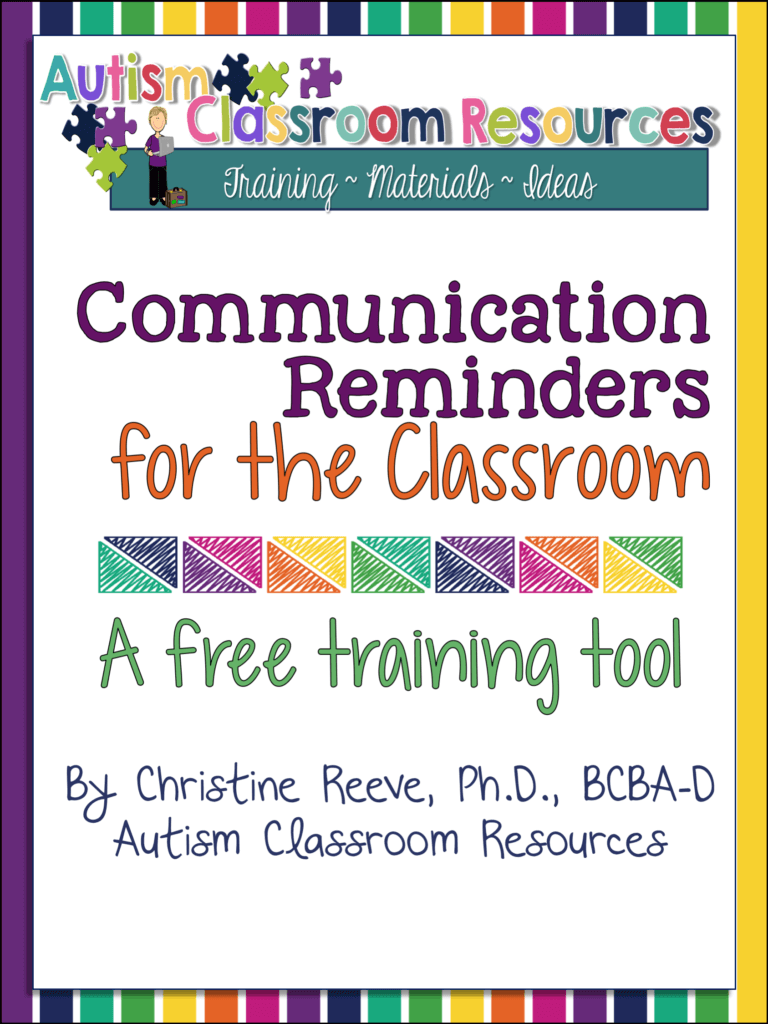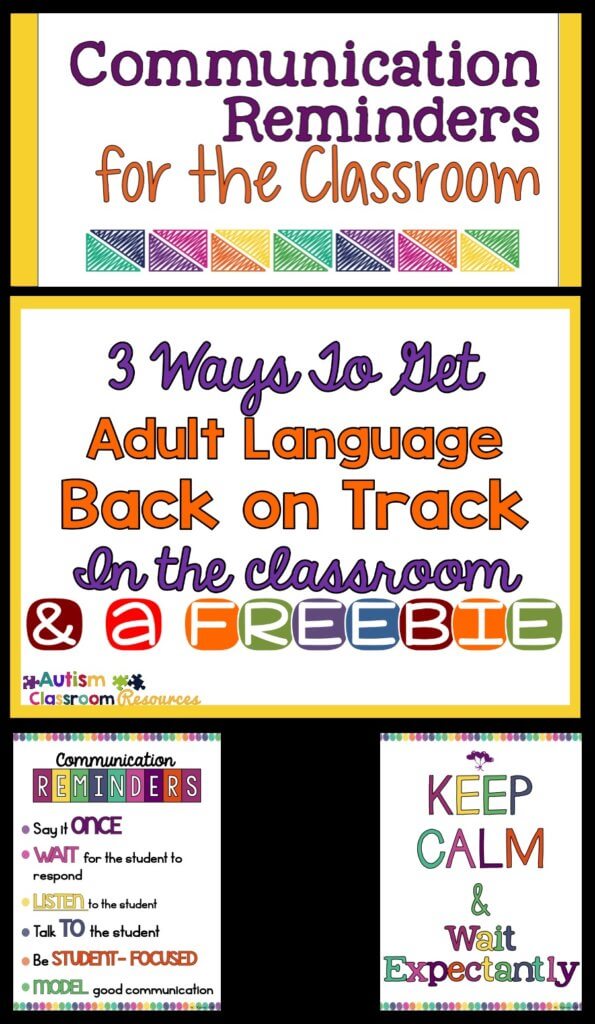I talked about the importance of using adult language in the classroom in a purposeful manner to model communication for students with autism in the last episode of the podcast. Today I am following up with a freebie to help teachers share the information with classroom staff. And I’m also sharing 3 ways that you can help all the classroom staff stay on track with adult language in the classroom. If you didn’t see the earlier post or listen to the podcast, please hop over and read it (I’ll wait) so that you know why being quiet can be an important goal and when it is appropriate (and when it’s not).
It isn’t easy to be quiet, refrain from repeating directions, and be careful about what we are saying in the classroom. And I realize that it is piled on a task that is already difficult of running the classroom. However, you can reduce stress of everyone in the room by reducing the adult noise in the classroom. Noisy environments promote stress.
So hopefully these ideas can help get adult language in the classroom back on track.
How Adult Language in the Classroom Gets Off-Track
It’s really hard to know how much you are talking in a classroom with everything else going on. I know that sounds crazy, but it’s true. I can’t tell you how many times I’ve been in a classroom and asked someone to stop talking for a minute for a student to respond. And the adult told me, “I’m not talking.” The person isn’t being difficult-. She didn’t realize she was talking.
It’s happened to all of us. We are so programmed to talk to the students and give directions. We have so much to get done, that we tend to talk and talk and talk, giving directions over and over without even realizing it. No one is immune to this problem–I promise. So how can we fix it?
1. Make a Pact About Adult Language in the Classroom
Have a team meeting and discuss why it’s important to take care about talking in the classroom and to talk purposefully. Remind staff the importance specifically to give clear directions and model well for the students.
Now you can do this in a couple of different ways, because I recognize there’s not a lot of time for team meetings in our world. You can share this information in a Google form. Make a short video. Or just make an announcement.
In this week’s freebie, there is a set of tips for training. So it’s kind of a handout that you can give to paras so that you’re giving them that information, even though you didn’t have time to really discuss it.
Then, the team can make an agreement that you will call each other on it with a subtle sign when you see a staff member talking too much. You could designate a sign (a quiet sign, a tug on your ear) ahead of time that means, “stop talking for a minute.”
Get Staff on Board With Why It’s Important
In order for this to work, it needs to be universal. It means that parapros can give you (the teacher) the sign when they hear you talking too much and you can do the same for them. It’s a way of helping people self-monitor and making them aware of when they are talking too much. The other nice thing is, it’s not a direction. Instead, it’s a friendly reminder.
To keep it friendly, it needs to be something that everyone on the team agrees is a priority. It also needs to be accepted by everyone. As a teacher the more you encourage staff to give you feedback on your behavior, the more they will be willing to accept feedback from you.
I talk a lot about that in episode 2, when I talk about building the classroom culture. Add it into your written classroom vision. Then use that as a reasoning behind what you’re doing the second way to try to get adult language back on track.
2. Get an Outsider’s Opinion
One of the advantages I have of consulting in classrooms is that I’m an outsider. In other words, I don’t live in the classroom everyday. That gives me a different perspective than when I’m the teacher or the parapro running the classroom. When I’m running the classroom, my brain is immersed in what I’m doing. When I’m a consultant, I get to stand back and watch.
Sometimes it’s helpful to have an outsider’s perspective. If the team doesn’t agree, ask a colleague, a speech therapist, or an administrator come in and do an observation. I know this can be uncomfortable, but sometimes an outsider can make the point more clearly to everyone on the team that we have to address adult language in the classroom. Speech pathologists can also come into the classroom to model and demonstrate how to effectively model communication and language.
What’s an Airplane Have to Do With It?
When I ran a program, I, we had a consultant come in and I was mortified because my staff was asking him all of the questions that I had been telling them all this time. And he was telling them the same thing I was saying, but they were listening to him. They weren’t listening to me because they hadn’t done any of it. I remember when we had lunch with. And I was mortified. I told him, I have been telling them all the things you told them today. And he looked at me and he said, “Chris, I know it’s not you. The difference is I flew in on an airplane. And that made me special.” And I have to tell you that was early in my career. And I thought it was kind of funny. I have to tell you, I’ve used it many times since then in my career, because there is some value of having people from the outside, give some feedback.
3. Use Visuals to Get Adult Language in the Classroom On Track
And finally, you know how much I love visuals for the students and for the adults. Put up reminders in the room about what to say and what to wait for.
You can put up posters with examples of scripted language for the adults. We used to do that in the preschool I worked at. I’m terrible at pretend play. I get caught up in trying to figure out what I’m teaching, and I don’t always feel like the language that I’m trying to model during play sounds right.
You can use scripts for the adults for pretend play to help them model during pretend play. For instance, narrating the child’s play, it might expand language that they might not think about in the midst of the activity. Similarly reminders of waiting for a student to respond or not repeating directions can be helpful.







